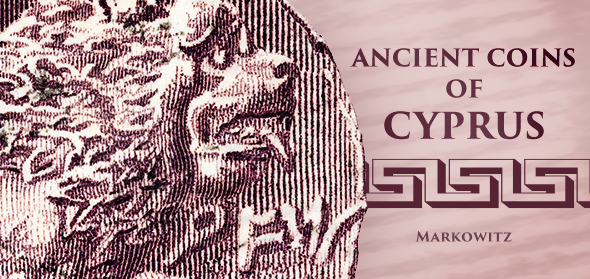
CoinWeek Ancient Coin Series by Mike Markowitz …..
ON A CLEAR day, it’s just possible to see the Turkish shore 40 miles (64 km) away from Cape St. Andreas[1] at the northeastern tip of Cyprus. The third-largest island in the Mediterranean after Sicily and Sardinia, Cyprus was settled in the ninth millennium BCE–possibly even earlier–by intrepid Neolithic mariners who somehow managed to cross that same gulf. Much of the copper that made the bronze by which the “Bronze Age” got its name was mined on Cyprus.
In Greek, the name of the island and the word for the metal are the same.
As a “crossroads of civilizations”, ancient Cyprus was home to a diversity of cultures: Greeks, Phoenicians, and an indigenous people know as Eteo-Cypriots, whose language, surviving in a few fragmentary inscriptions, is still largely undeciphered. Egyptian, Assyrian, and Persian empires asserted control over the island but allowed local elites to manage their own affairs. By the time coinage came into general use in the fifth century BCE, Cyprus consisted of about 10 “city-kingdoms”, coexisting uneasily.
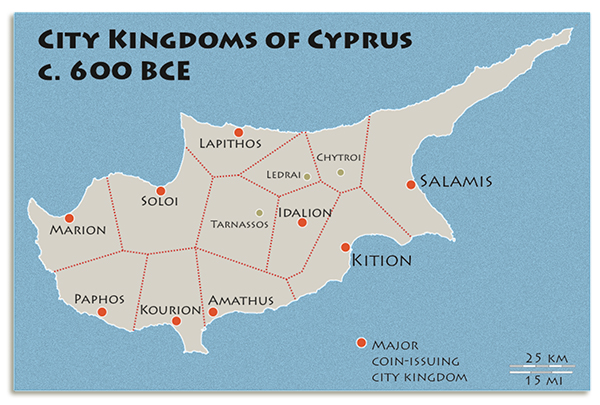
Salamis
Salamis, on the eastern coast, was probably the first and, for centuries, the most important coin-issuing city on the island.
The earliest coins were crude, single-sided silver pieces bearing the image of a recumbent ram. They are attributed to King Evelthon (or Euelthon), who reigned from 569 to 525 BCE. The weight standard, described as a “stater” (Greek) or “double siglos” (Persian), was about 11 grams, and there were some rare fractions. Coins became double-sided under Evelthon’s successors, often bearing the Egyptian ankh symbol. In the mid-fourth century BCE, the indigenous Cypriot syllabic script was gradually replaced by Greek letters for coin inscriptions.
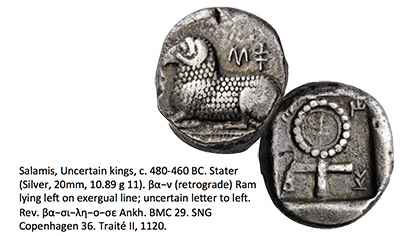 Under King Evagoras I (411-374 BCE) who extended his rule over much of the island, the coinage reached a high artistic standard, with images of the cult hero Herakles, and naturalistically rendered animals such as goats. A small but spectacular gold quarter-stater of Evagoras bears a youthful portrait of Herakles in the “three-quarters facing” orientation; a technically-challenging design rare in the Greek art of this era. An example of this type sold for almost US$48,000 in a May 2015 European auction.
Under King Evagoras I (411-374 BCE) who extended his rule over much of the island, the coinage reached a high artistic standard, with images of the cult hero Herakles, and naturalistically rendered animals such as goats. A small but spectacular gold quarter-stater of Evagoras bears a youthful portrait of Herakles in the “three-quarters facing” orientation; a technically-challenging design rare in the Greek art of this era. An example of this type sold for almost US$48,000 in a May 2015 European auction.
 Pnytagoras (351-332 BCE) was one of the last independent kings of Salamis, before it was absorbed by Alexander the Great. His fleet assisted Alexander at the epic siege of Tyre (332). Pnytagoras issued impressive gold staters with the head of Aphrodite (also identified as the Phoenician fertility goddess Astarte) on both sides. On the obverse she wears a turreted crown as a city goddess; on the reverse she wears a simple tiara.
Pnytagoras (351-332 BCE) was one of the last independent kings of Salamis, before it was absorbed by Alexander the Great. His fleet assisted Alexander at the epic siege of Tyre (332). Pnytagoras issued impressive gold staters with the head of Aphrodite (also identified as the Phoenician fertility goddess Astarte) on both sides. On the obverse she wears a turreted crown as a city goddess; on the reverse she wears a simple tiara.
On Pnytagoras’ silver coinage, Aphrodite is paired with a youthful androgynous image of Apollo. The king’s name is abbreviated to two Greek letters ΠΝ.
Paphos
According to myth, Paphos is where Aphrodite was born from the foam of the sea. Her earliest Greek temple here was built in the 12th century BCE on the site of a shrine to an earlier local goddess.
The earliest coinage of this city on the southwest coast is anonymous, bearing the image of a bull beneath a winged solar disk – probably a sign of Egyptian influence. A handsome archaic stater in the American Numismatic Society (ANS) collection pairs the bull with a flying eagle in an incuse square on the reverse. On the coinage of King Stasandros (late fifth century BCE) the obverse bull is accompanied by a reverse with a standing eagle and a sprig of olive leaves. Silver coins as small as 1/24 siglos were struck (10 mm in diameter, weighing about half a gram).
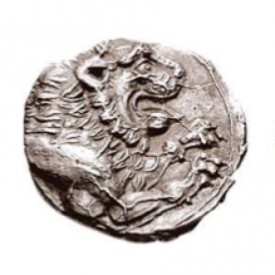 Amathus
Amathus
Amathus, on the south coast, was one of the last strongholds of the Eteo-Cypriot language and culture. The coinage is quite rare and mostly anonymous; issues of a king named Rhoikos (ca. 360-355 BCE) seem to be the most common. The coins typically carry the image of a roaring lion on both sides. When Evagoras of Salamis briefly controlled Amathus (ca. 410-374 BCE), he continued to use the lion emblem on the city’s coinage, adding his own Greek initial.
Kition
 Kition (Citium in Latin, or Kittim in Phoenician) was the most important Phoenician city of ancient Cyprus. The extensive silver and gold coinage of Kition typically carries the king’s name in Phoenician letters. The obverse bears an image of Herakles (identified by Phoenicians as Melqart, the patron god of the city of Tyre) brandishing his club and holding his bow. The reverse shows a lion attacking a stag–a dynamic scene common in ancient Near Eastern royal art. The last independent king of Kition, Pumayyaton (“Pygmalion” in Greek) was defeated and killed in 312 BCE by Ptolemy I of Egypt.
Kition (Citium in Latin, or Kittim in Phoenician) was the most important Phoenician city of ancient Cyprus. The extensive silver and gold coinage of Kition typically carries the king’s name in Phoenician letters. The obverse bears an image of Herakles (identified by Phoenicians as Melqart, the patron god of the city of Tyre) brandishing his club and holding his bow. The reverse shows a lion attacking a stag–a dynamic scene common in ancient Near Eastern royal art. The last independent king of Kition, Pumayyaton (“Pygmalion” in Greek) was defeated and killed in 312 BCE by Ptolemy I of Egypt.
Idalion
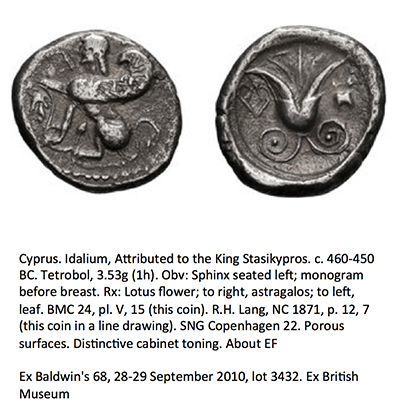 Idalion (or Idalium) is the only inland city that was a major coin issuing center. The city’s emblem was the sphinx — not the familiar pharaonic Egyptian monument, but the mythical Greek creature with the body of a lion, the wings of an eagle, the head of a woman and a fondness for riddles.
Idalion (or Idalium) is the only inland city that was a major coin issuing center. The city’s emblem was the sphinx — not the familiar pharaonic Egyptian monument, but the mythical Greek creature with the body of a lion, the wings of an eagle, the head of a woman and a fondness for riddles.
Idalion’s wealth was based on copper mining.
Coinage began early, about 500 BCE, with silver staters bearing an obverse image of a sphinx, and a rough punch mark on the reverse. By the time of King Stasikypros (ca. 460-450 BCE), the coins show a stylized lotus flower as the reverse. A common additional symbol is the astragalos, the knucklebone of a sheep, used like dice in an ancient game[2].
Lapithos
Lapithos (or Lapethus) on the north coast was inhabited as early as the third millennium BCE, but Greeks believed it was founded as a Spartan colony. The coinage, mostly uninscribed, bears images of Aphrodite and Athena. A remarkable silver stater dated to around 435 BCE shows a facing head of Athena wearing a crested helmet in the style worn by Spartan officers: with the crest running from left to right rather than front to back.
Marion
Founded in the seventh century BCE, Marion (or Marium) on the northwest coast, grew rich on trade in copper and timber. The names of least four kings are known from coins; all but the last are quite rare: Sasmai (or Sasamarios, ca. 470-450 BCE,) Stasioikos (ca. 370), Timochares (ca. 365) and Stasioikos II (330-312; deposed by Ptolemy I of Egypt). The coinage often bears images of Apollo, Zeus and Aphrodite.
 Collecting Ancient Cyprus
Collecting Ancient Cyprus
Ancient Cypriot coins are scarce. The vast British Museum collection database lists 297 Cypriot coins from our period of interest (600-336 BCE). Many were acquired by gift or purchase in the 19th century from private collectors. The American Numismatic Society has 439 (17 gold, 54 bronze, the rest silver), many from the bequest of the eminent numismatist Edward T. Newell (1886-1941).
Current coin auctions rarely have more than a few Cypriot coins. For example, in the January 2012 New York sale of the spectacular Prospero Collection, there were only three Cypriot coins out of 641 lots: a stater of Lapethos and two Evagoras I staters of Salamis. Out of over 900 Greek coins in the January 2015 Triton XVIII sale, only two were Cypriot, both staters of Salamis.
Collecting ancient Cypriot coins presents a particular challenge for Americans because importation of “coins of Cypriot type” that are more than 250 years old into the United States is forbidden under a Memorandum of Understanding (MoU) between the U.S. State Department and the Government of Cyprus. To import such coins legally, the burden of proof is on the importer to document that the material was outside Cyprus before 16 July 2002, which is when the MoU was signed. Typically this is done by providing an image of the coin in a sale catalog.
There are no such restrictions for collectors on Cyprus and within the European Union, where ancient Cypriot coins are freely traded (Tompa).
* * *
Notes
[1] Zafer Burnu in Turkish.
[2] https://en.wikipedia.org/wiki/Knucklebones.
References
Destrooper-Giorgiades, Anne. “Le monnayage de Paphos au IVe s., nouvelles perspectives.” XIII Congreso Internacional de Numismática, Madrid. (2003)
Hadjisavvas, Sophocles (ed.) Cyprus: Crossroads of Civilizations. Government of the Republic of Cyprus. Nicosia. (2010)
Hill. G.F. Catalogue of the Greek Coins of Cyprus. British Museum (1904)
Kagan, Jonathan. “An Archaic Greek Coin Hoard from the Eastern Mediterranean and Early Cypriot Coinage.” Numismatic Chronicle 154 (1994)
Markou, Evangeline. “Gold and Silver Weight Standards in Fourth Century Cyprus”, Proceedings of the XIV International Numismatic Congress. Glasgow (2009)
Markou, Evangeline, A. Charalambous and V. Kassianidou. “Symbols on the Ancient and Classical Cypriot Coinage: Influences, Duration and Diffusion”, Proceedings, First International Congress of the Anatolian Monetary History and Numismatics. Antalya (2013)
Markou, Evangeline. “pXRF Analysis of Cypriot Gold Coins of the Classical Period.” American Journal of Numismatics 26 (2014)
The New York Sale, Auction XXVII, The Prospero Collection (2012)
Tompa, Peter K. and Ann M. Brose. “A Modern Challenge to an Age-Old Pursuit: Can Patrimony Claims and Coin Collecting Coexist?”, Who Owns the Past: Cultural Policy, Cultural Property, and the Law. Rutgers (2005)
* * *





I have a coin I was give by my grandfather when I was a young boy, maybe 50 years ago.
My grandfather worked in the goldmines in the mountains, He found the coin in the mine.
I have never tried to value this coin as I am not sure who to ask.
Maybe you can help?
Kind Regard
Chris